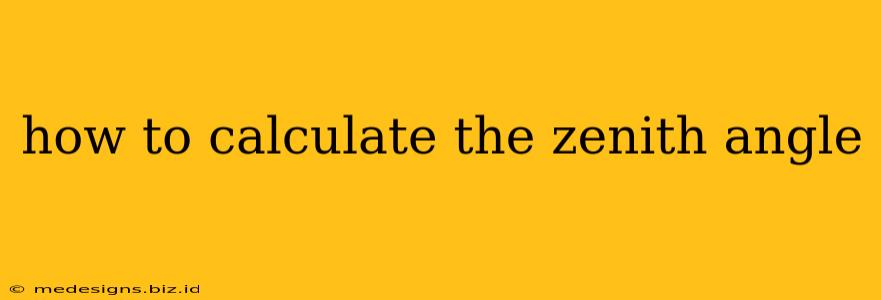The zenith angle is a crucial parameter in solar energy calculations, meteorology, and astronomy. It represents the angle between the sun and the zenith, which is the point directly overhead. Understanding how to calculate this angle is vital for various applications, from determining solar panel efficiency to predicting weather patterns. This comprehensive guide will walk you through different methods of calculating the zenith angle, equipping you with the knowledge to tackle various scenarios.
Understanding the Zenith Angle
Before diving into the calculations, let's solidify our understanding of the zenith angle. Imagine a line drawn from your location straight up towards the sky – that's your zenith. The zenith angle is the angle formed between this line and a line pointing directly at the sun. A zenith angle of 0° means the sun is directly overhead, while a zenith angle of 90° means the sun is on the horizon.
Several factors influence the zenith angle:
- Time of day: The sun's position changes throughout the day, directly affecting the zenith angle.
- Day of the year: The earth's tilt on its axis and its orbit around the sun cause the sun's position to vary throughout the year.
- Latitude: Your location's latitude significantly impacts the sun's maximum elevation and thus the minimum zenith angle.
- Longitude: While less impactful than latitude, longitude slightly affects the precise time of solar events.
Methods for Calculating the Zenith Angle
There are several methods to calculate the zenith angle, ranging from simple approximations to complex equations incorporating various astronomical parameters.
1. Using the Simplified Formula (Approximation)
For quick estimations, a simplified formula can be employed. This formula offers a reasonable approximation, especially for educational purposes or preliminary assessments. However, it lacks the precision of more advanced methods. Remember, this method ignores atmospheric refraction.
Formula: cos(θz) = sin(δ)sin(φ) + cos(δ)cos(φ)cos(h)
Where:
- θz is the zenith angle (in degrees)
- δ is the solar declination (in degrees) – this changes daily and can be found in astronomical tables or online calculators.
- φ is the latitude (in degrees) of the location.
- h is the hour angle (in degrees) – this represents the sun's angular distance from the local meridian, which is 15 degrees per hour. For instance, at noon, h = 0°.
2. Employing More Accurate Equations (Considering Atmospheric Refraction)
For higher accuracy, particularly in applications requiring precise measurements like solar energy calculations, you need to account for atmospheric refraction. Atmospheric refraction bends sunlight as it passes through the Earth's atmosphere, slightly altering the apparent position of the sun. This necessitates a more complex calculation. Dedicated solar geometry software or online calculators often incorporate these adjustments.
Several sophisticated equations exist to calculate zenith angle with atmospheric refraction; these usually involve iterative solutions and often include factors like atmospheric pressure and temperature to fine-tune the result.
3. Using Online Calculators and Software
Numerous online calculators and specialized software packages are available for calculating the zenith angle accurately. These tools often incorporate all relevant parameters, including atmospheric refraction, and provide detailed results. Simply input your location's coordinates, date, and time, and the calculator will provide the zenith angle. Many of these tools also calculate other solar angles like the azimuth angle.
Practical Applications of Zenith Angle Calculations
The zenith angle finds applications across various fields:
- Solar Energy: Optimizing the tilt angle of solar panels requires knowing the zenith angle to maximize energy capture.
- Agriculture: Understanding solar radiation (influenced by zenith angle) helps in crop planning and irrigation scheduling.
- Meteorology: Zenith angle is used in various weather models and analyses.
- Architecture: Building design and shading strategies benefit from accurate zenith angle calculations for optimal natural lighting and thermal comfort.
- Astronomy: Determining the sun's apparent position is essential for astronomical observations and calculations.
Conclusion: Mastering Zenith Angle Calculations
Calculating the zenith angle might initially appear complex, but understanding the underlying principles and utilizing the appropriate methods allows for accurate determination. Whether you opt for a simplified approximation or leverage more precise equations and software, mastering zenith angle calculation enhances understanding and application in numerous fields. Remember to select the method that best suits your accuracy requirements and available resources.
